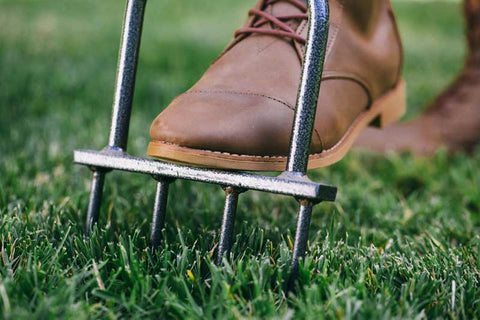Why Aeration Matters for Your Lawn's Health
Let's start with the basics: why does aeration matter? Think of your lawn like a sponge. Over time, foot traffic, lawn mowers, and even the natural settling of soil can cause the ground to become compacted. When this happens, it's harder for water, air, and nutrients to penetrate the soil and reach the roots of your grass. That's where aeration comes in. By perforating the soil with small holes, you're allowing oxygen, water, and nutrients to get where they need to go, promoting healthier grass growth from the ground up.Signs Your Lawn Needs Aeration
But how do you know if your lawn needs aeration? Keep an eye out for signs like water pooling on the surface after rain, grass that's slow to green up in the spring, or areas where the soil feels particularly hard and compacted. If you notice any of these signs, it's probably time to break out the aerator.Different Methods of Lawn Aeration Explained
When it comes to aerating your lawn, there are a few different methods to choose from. The most common are spike aerators and core aerators. Spike aerators use solid tines to poke holes in the soil, while core aerators remove small plugs of soil, allowing for better air circulation. Both methods have their pros and cons, so choose the one that works best for your lawn and your budget. Let's take a closer look at the various options and the tools available for each:Spike Aerators:

Core Aerators:
Core aerators, also called plug aerators, remove small plugs of soil from the ground, allowing for better air circulation and water absorption. While core aerators can be more labor-intensive and expensive than spike aerators, they typically provide more thorough aeration and are better suited for compacted soils. Core aerators come in several varieties, including walk-behind models with rotating drums or wheels that puncture the soil, as well as larger tow-behind attachments for use with riding lawn mowers or tractors.Liquid Aeration:
For those looking for a less invasive alternative to mechanical aeration, liquid aerators offer a convenient solution. These products are typically applied to the lawn using a sprayer or hose-end attachment and work by loosening compacted soil and promoting root growth. While liquid aerators may not be as effective as mechanical aerators for heavily compacted soils, they can be a good option for maintaining overall soil health and preventing future compaction.Manual Core Aerators:

Spiked Shoes:
For quick and easy aeration on a small scale, spiked shoes are a convenient option. These strap-on footwear feature spikes on the soles that you can use to walk around the lawn, aerating as you go. While spiked shoes may not be as effective as mechanical aerators for deeply compacted soils, they can be a useful tool for maintaining soil health between more intensive aeration sessions.Choosing the Right Tool for Your Lawn
When selecting an aerator for your lawn, consider factors such as the size of your lawn, the type of grass you have, and the level of compaction in your soil. For small to medium-sized lawns with moderate compaction, a spike aerator or manual core aerator may be sufficient. However, for larger lawns or heavily compacted soils, a powered core aerator or tow-behind attachment may be necessary to achieve optimal results.Best Times to Aerate Your Lawn for Optimal Results
Timing is everything when it comes to lawn care, and aeration is no exception. The best time to aerate your lawn is during the growing season, when the grass is actively growing and can recover more quickly from the stress of aeration. For cool-season grasses like Kentucky bluegrass and fescue, early fall or spring are ideal. Warm-season grasses like Bermuda and zoysia, on the other hand, benefit most from aeration in late spring or early summer.Step-by-Step Guide: How to Aerate Your Lawn Like a Pro
Ready to get started? Here's a step-by-step guide to aerating your lawn like a pro:Prepare Your Lawn: Before you start aerating, make sure your lawn is well-watered and free of debris.
Choose Your Aerator: Decide whether you'll be using a spike aerator or a core aerator, and rent or purchase the appropriate equipment.
Aerate Your Lawn: Start at one corner of your lawn and work your way across in a grid pattern, making sure to overlap each pass slightly.
Fill in Bare Spots: If you notice any bare spots or thin areas of grass, now's the perfect time to overseed.
Water and Fertilize: After aerating, give your lawn a good watering to help the soil settle and encourage new grass growth. This is also a great time to apply a slow-release fertilizer to give your grass the nutrients it needs to thrive.






